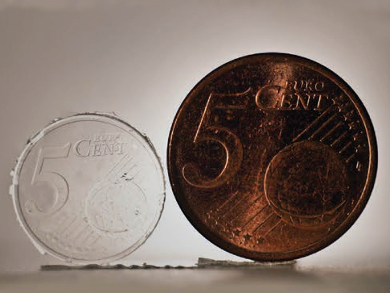Glass has many advantages as a material for chemical applications, such as optical transparency, thermal and chemical resistance. Rapid prototyping and microstructuring of glass devices has, however, been difficult. Commonly used wet etching techniques require hazardous hydroflouric acid and are time-consuming. In addition, the etching process is isotropic and cannot be used to generate features such as, e.g., perpendicular pillars for microfluidic devices.
Bastian E. Rapp, Karlsruhe Institute of Technology (KIT), Germany, and colleagues have developed “Liquid Glass”, a photocurable, amorphous silica nanocomposite that can be structured using soft polymer molds and turns into glass after sintering. The composite consists of a silica nanopowder with a mean diameter of 40 nm, dispersed in a mixture of the photocurable monomer hydroxyethylmethacrylate (HEMA) and the solvent phenoxyethanol (POE).
To produce the desired shapes, the material is poured onto a poly(dimethylsiloxane) (PDMS) mold and cured using UV-light. The cured material layers can be fused by simple polymer bonding techniques, which allows the fabrication of complex microsystems such as microfluidic chips. Finally, the components are sintered at 1300 °C to give glass parts that are nearly indistinguishable from commercial fused silica glass. During sintering, the parts shrink isotropically by roughly 26 %.
The researchers tested the chemical stability of the resulting glass using a range of organic solvents and aqueous solutions of varying pH values. Even after one week, no swelling or defects in the material could be observed.
- Liquid Glass: A Facile Soft Replication Method for Structuring Glass,
Frederik Kotz, Klaus Plewa, Werner Bauer, Norbert Schneider, Nico Keller, Tobias Nargang, Dorothea Helmer, Kai Sachsenheimer, Michael Schäfer, Matthias Worgull, Christian Greiner, Christiane Richter, Bastian E. Rapp,
Adv. Mater. 2016.
DOI: 10.1002/adma.201506089




